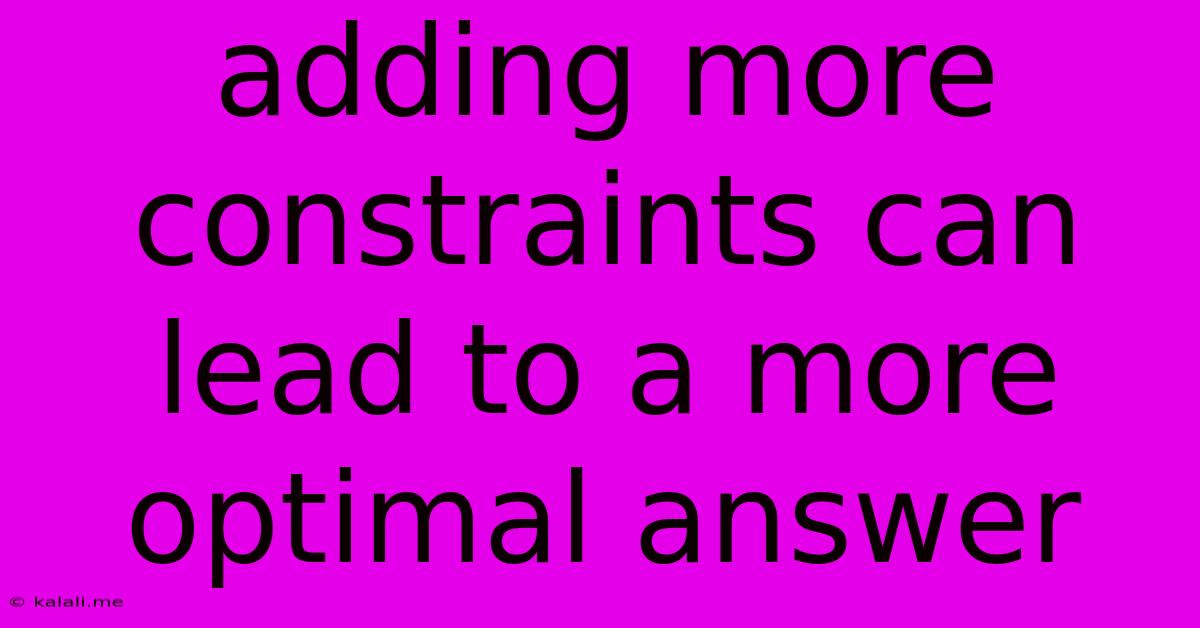Adding More Constraints Can Lead To A More Optimal Answer
Kalali
Jun 04, 2025 · 3 min read

Table of Contents
Adding More Constraints: The Path to Optimal Solutions
Finding the perfect solution is often a journey of balancing freedom and restriction. While unrestricted exploration might seem ideal, paradoxically, adding more constraints can surprisingly lead to a more optimal answer. This counterintuitive approach is prevalent in various fields, from problem-solving and design to artificial intelligence and scientific research. This article explores why embracing limitations can be the key to unlocking superior outcomes.
Meta Description: Discover how adding constraints, seemingly limiting, can paradoxically lead to more creative and optimal solutions. Learn the techniques and applications of constraint-based problem-solving.
This might seem contradictory at first glance. After all, shouldn't more options lead to better outcomes? While having a wide range of possibilities is important, an overabundance of choices can lead to analysis paralysis, hindering progress and potentially resulting in a suboptimal selection. Constraints, in contrast, act as filters, focusing our attention on the most promising avenues and guiding us towards a more refined solution.
Why Constraints Enhance Problem-Solving
Constraints serve several crucial roles in achieving optimal solutions:
-
Reduced Search Space: With fewer options to consider, the search space for the ideal solution shrinks dramatically. This simplifies the problem, making it easier to evaluate potential answers and identify the best fit. Think of it like searching for a needle in a haystack – a smaller haystack makes the task significantly easier.
-
Increased Focus and Clarity: Constraints force us to prioritize and make difficult choices. This focused approach helps to refine the problem definition, revealing underlying assumptions and potentially uncovering hidden opportunities. By eliminating less viable options, we can concentrate our energy on those with the highest potential.
-
Enhanced Creativity and Innovation: Ironically, limitations can spark creativity. When faced with restrictions, we are compelled to think outside the box, to find innovative solutions that work within the given boundaries. Many breakthrough inventions have arisen from constraints – necessity, as they say, is the mother of invention.
-
Improved Efficiency and Resource Allocation: Constraints naturally lead to greater efficiency. By focusing on a smaller set of possibilities, we can optimize resource allocation, minimizing wasted effort and maximizing productivity.
Examples of Constraints Leading to Optimal Answers
The power of constraints is evident in various fields:
-
Design: In graphic design, constraints like color palettes, font choices, and aspect ratios often result in more impactful and visually appealing designs. The limitations force designers to be more intentional and creative in their choices.
-
Software Development: Agile development methodologies employ constraints like time-boxed sprints and iterative development to improve project management and deliver higher-quality software.
-
Engineering: Engineers often work with strict constraints related to budget, materials, and physical limitations. These constraints are essential for building functional and efficient systems.
-
Music Composition: Composers frequently use constraints like key signatures, time signatures, and rhythmic patterns to structure their compositions and create cohesive musical pieces. The limitations actually enhance artistic expression.
-
Artificial Intelligence: Constraint satisfaction problems (CSPs) are a significant area in AI, where algorithms solve problems by finding assignments that satisfy a set of constraints. This is used in various applications, from scheduling and resource allocation to puzzle solving and robotics.
Conclusion: Embracing the Power of Limitations
While the instinct might be to seek maximum freedom in problem-solving, adding constraints can be a powerful strategy for achieving truly optimal solutions. By reducing complexity, fostering creativity, and improving efficiency, constraints can unlock unforeseen possibilities and guide us towards superior outcomes. The next time you're facing a challenge, consider the potential benefits of embracing limitations—you might be surprised by the results.
Latest Posts
Latest Posts
-
How To Seal Window Ac Unit
Jun 06, 2025
-
How To Prove Circles Have Most Perimeter
Jun 06, 2025
-
Can You Heat Up Cold Brew Coffee
Jun 06, 2025
-
Darling In The Franxx Manga Nudes
Jun 06, 2025
-
Signed Pearl Harbor Childrens Book Value
Jun 06, 2025
Related Post
Thank you for visiting our website which covers about Adding More Constraints Can Lead To A More Optimal Answer . We hope the information provided has been useful to you. Feel free to contact us if you have any questions or need further assistance. See you next time and don't miss to bookmark.